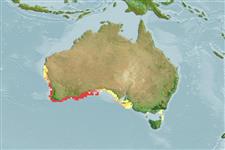Teleostei (teleosts) >
Ovalentaria/misc (Various families in series Ovalentaria) >
Pomacentridae (Damselfishes) > Chrominae
Etymology: Chromis: Greek, chromis = a fish, perhaps a perch (Ref. 45335).
Eponymy: Dr Carl Benjamin Klunzinger (1834–1914) was a German physician and zoologist. [...] (Ref. 128868), visit book page.
More on author: Whitley.
Environment: milieu / climate zone / depth range / distribution range
Ecology
Marine; reef-associated; non-migratory; depth range 2 - 20 m. Subtropical
Eastern Indian Ocean: western Australia between the Recherche Archipelago and Abrolhos Islands.
Size / Weight / Age
Maturity: Lm ? range ? - ? cm
Max length : 6.5 cm SL male/unsexed; (Ref. 7247)
Short description
Identification keys | Morphology | Morphometrics
Adults inhabit inshore and offshore coral reefs (Ref. 7247). Oviparous, distinct pairing during breeding (Ref. 205). Eggs are demersal and adhere to the substrate (Ref. 205). Males guard and aerate the eggs (Ref. 205).
Life cycle and mating behavior
Maturity | Reproduction | Spawning | Eggs | Fecundity | Larvae
Oviparous, distinct pairing during breeding (Ref. 205). Eggs are demersal and adhere to the substrate (Ref. 205). Males guard and aerate the eggs (Ref. 205).
Allen, G.R., 1991. Damselfishes of the world. Mergus Publishers, Melle, Germany. 271 p. (Ref. 7247)
IUCN Red List Status (Ref. 130435: Version 2024-1)
Threat to humans
Harmless
Human uses
Tools
Special reports
Download XML
Internet sources
Estimates based on models
Preferred temperature (Ref.
123201): 16.8 - 22.1, mean 18 °C (based on 109 cells).
Phylogenetic diversity index (Ref.
82804): PD
50 = 0.5000 [Uniqueness, from 0.5 = low to 2.0 = high].
Bayesian length-weight: a=0.01820 (0.00804 - 0.04119), b=2.99 (2.81 - 3.17), in cm total length, based on LWR estimates for this Genus-body shape (Ref.
93245).
Trophic level (Ref.
69278): 2.7 ±0.30 se; based on food items.
Resilience (Ref.
120179): High, minimum population doubling time less than 15 months (Preliminary K or Fecundity.).
Fishing Vulnerability (Ref.
59153): Low vulnerability (10 of 100).
Nutrients (Ref.
124155): Calcium = 104 [43, 197] mg/100g; Iron = 0.876 [0.472, 1.710] mg/100g; Protein = 18.8 [17.5, 20.0] %; Omega3 = 0.182 [0.091, 0.350] g/100g; Selenium = 9.9 [4.2, 22.2] μg/100g; VitaminA = 67.7 [15.6, 268.7] μg/100g; Zinc = 1.45 [0.86, 2.34] mg/100g (wet weight);
